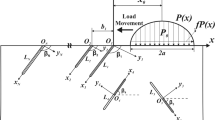Abstract
A model has been developed to predict crack opening and closing behavior for propagating fatigue cracks which undergo significant sliding displacements at crack flanks. Crack surfaces were described statistically by assuming a random distribution of asperity heights and a mean density of asperities and asperity radii. The propagating crack was subdivided into strips, and each strip was treated as a contact problem between two randomly rough surfaces. The remote tensile stresses were varied in a cyclical manner. The contact stresses at minimal load were determined by analyzing the local crushing of asperities via a sliding mechanism. Then, upon loading, the crack opening stress levels were computed when the contact stresses were overcome. Part 1 of this article includes a discussion of the previous models, then introduces statistical contact mechanics concepts which are utilized in the fatigue crack growth simulations. In addition, the numerical algorithms for the modeling work and the sensitivity of results to model parameters are described. The role of stress ratio, maximum stress level, crack length, and the geometry of crack surfaces on the crack growth behavior will be discussed in Part 2 of this article.
Similar content being viewed by others
References
H. Sehitoglu and A. Garcia: Metall. Mater. Trans. A, 1997, vol. 28A, pp. 2277–89.
S. Suresh: Fatigue of Materials, Cambridge University Press, Cambridge, United Kingdom, 1991.
H. Sehitoglu, K. Gall, and A.M. Garcia: Int. J. Fract., 1996, vol. 80 (2–3), pp. 165–92.
K.L. Johnson: Contact Mechanics, Cambridge University Press, Cambridge, United Kingdom, 1985.
N.J. Adams: Eng. Fract. Mech., 1972, vol. 4, pp. 543–54.
S. Purushothan and J.K. Tien: Scripta Metall., 1975, vol. 9, pp. 923–26.
N. Walker and C.J. Beevers: Fatigue of Engineering Materials and Structures, 1979, vol. 1, pp. 135–48.
D.L. Davidson and J. Lankford: Mater. Sci. Eng., 1983, vol. 60, pp. 225–29.
K. Minakawa and A.J. McEvily: Scripta Metall., 1981, vol. 15, pp. 633–36.
J.E. Allison and J.C. Williams: Titanium Science and Technology, G. Lujtering, U. Zwicker, and W. Burk, eds., DGM Publishers, Oberusel, 1985, vol. 1, pp. 2243–50.
J.M. Larsen: Ph.D. Thesis, Carnegie Mellon University, Pittsburgh, PA, 1987; also J.M. Larsen, J.C. Williams, and A.W. Thompson: ASTM STP 982, ASTM, Philadelphia, PA, 1988, pp. 149–67.
G.T. Gray III, J.C. Williams, and A.W. Thompson: Metall. Trans. A, 1983, vol. 14A, pp. 421–33.
D. Krueger, S.D. Antolovich, and R.H. Van Stone: Metall. Trans. A, 1987, vol. 18A, pp. 1431–49.
C.P. Blankenship and E.A. Starke: Fatigue Fract. Eng. Mater. Struct., 1991, vol. 14, pp. 103–14.
R.D. Carter, E.W. Lee, E.A. Starke, and C.J. Beevers: Metall. Trans. A, 1984, vol. 15A, pp. 555–63.
S. Suresh: Metall. Trans. A, 1983, vol. 14A, pp. 2375–85.
B. Cotterell and J. Rice: Int. J. Fract., 1980, vol. 16, pp. 155–69.
S. Suresh and R.O. Ritchie: Metall. Trans. A, 1982, vol. 13A, pp. 1627–31.
M.C. Smith and R.A. Smith: ASTM STP 924, ASTM, Philadelphia, PA, 1988, pp. 260–80.
H. Nakamura and H. Kobayashi: ASTM STP 982, Philadelphia, PA, 1988, pp. 459–74.
C.J. Beevers, K. Bell, R.L. Carlson, and E.A. Starke: Eng. Fract. Mech., 1984, vol. 19 (1), pp. 93–100.
J. Llorca: Fatigue Fract. Eng. Mater. Struct., 1992, vol. 15 (7), pp. 655–69.
R.L. Carlson and C.J. Beevers: Eng. Fract. Mech., 1984, vol. 20, pp. 687–90.
J. Tong, J.R. Yates, and M.W. Brown: Eng. Fract. Mech., 1995, vol. 52 (4), pp. 613–23.
J.A. Greenwood and J.P.B. Williamson: Proc. R. Soc. London, vol. A295, pp. 300–19.
S.P. Timoshenko and J.N. Goodier: Theory of Elasticity, McGraw-Hill, New York, NY, 1987.
J.A. Greenwood and J.H. Tripp: Proc. Inst. Mech. Eng., 1971, vol. 185, pp. 625–33.
K.L. Johnson and H.R. Shercliff: Int. J. Mech. Sci., 1992, vol. 34 (5), pp. 375–94.
A. Kapoor and K.L. Johnson: Leeds-Lyon Symp. on Tribology, 1993, pp. 81–90.
J.C. Newman, Jr.: ASTM STP 748, ASTM, Philadelphia, PA, 1981, pp. 53–84.
H.A. Francis: Wear, 1982, vol. 76, pp. 221–45.
W.R. Chang, I. Etsion, and D.B. Bogy: J. Tribol., 1987, vol. 109, pp. 257–63.
Y. Jiang and H. Sehitoglu: Wear, 1996, vol. 191, pp. 35–44.
R.O. Ritchie, W. Yu, A. Blom, and D. Holm: Fatigue Fract. Eng. Mater. Struct., 1987, vol. 10 (5), pp. 343–62.
Author information
Authors and Affiliations
Rights and permissions
About this article
Cite this article
García, A.M., Sehitoglu, H. Contact of crack surfaces during fatigue: Part 1. formulation of the model. Metall Mater Trans A 28, 2263–2275 (1997). https://doi.org/10.1007/s11661-997-0184-5
Received:
Issue Date:
DOI: https://doi.org/10.1007/s11661-997-0184-5




